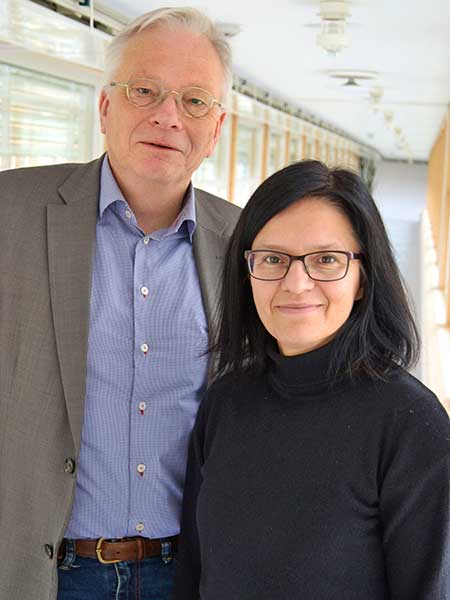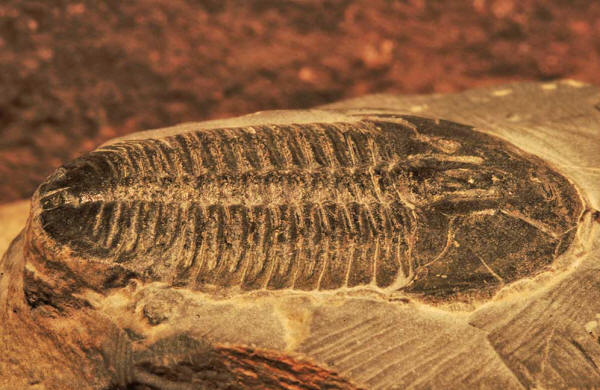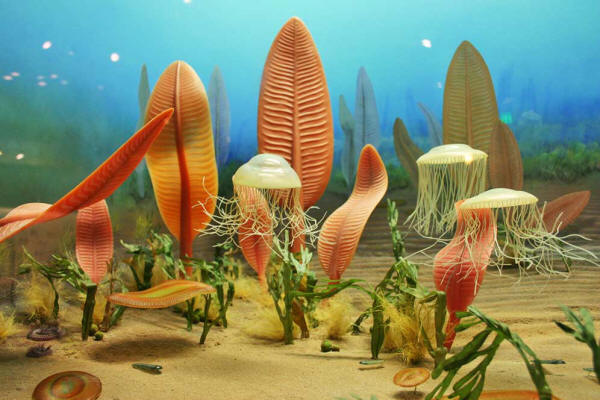|
from
QuantaMagazine Website that erupted half a billion years ago during the Cambrian explosion may have been enabled by genetic developments that allowed cells to protect themselves better
against the effects of oxygen.
for Quanta Magazine
An unlikely team offers a controversial hypothesis about what enabled animal life to get more complex and diverse during the Cambrian explosion...
He was a tumor biologist, after all, and she was a geobiologist, someone who studied the interplay between living organisms and their environment.
Påhlman
didn't see how his work could possibly inform her search for answers
about the rapid proliferation and diversification of animal life
that, half a billion years ago, forever changed Earth's evolutionary
landscape.
Not until about 540 million years ago did larger, more complex species begin to dominate the oceans, but within just a few tens of millions of years (a blip on the evolutionary timescale), the planet had filled up with all kinds of animals.
The fossil record from that period shows the beginnings of almost all modern animal lineages:
combined their expertise in tumor biology and geology, respectively, to put forth a new hypothesis on
why
animals diversified half a billion years ago.
One of the leading theories about this hotly debated question holds that a skyrocketing rise in atmospheric oxygen around that time triggered what's known as the Cambrian explosion.
Earlier, when oxygen was scarce, the simple animals in the seas had anaerobic metabolisms that did not depend on it, and they even found oxygen problematic if not toxic.
By shifting to aerobic respiration, however, animals gained an enormous metabolic advantage because the amount of energy that cells could produce per respiration cycle increased nearly twentyfold.
That extra energy may have been what powered the greater complexity witnessed during the Cambrian period:
Nevertheless, animals in that period would have needed to
develop physiological innovations to deal with the abundance of
oxygen.
of complex and diverse animal life dating back to approximately 540 million years ago. One of the most abundant and iconic creatures of the era was the trilobite, an armored animal that flourished for tens of millions of years.
Pictured here, a fossil of the trilobite Elrathia kingii.
To
prove it, she needed Påhlman's help. In particular, she needed his
knowledge of
stem cells and cancer.
Throughout life, they play
a crucial part in the regeneration and repair of tissues. Scientists
are still trying to find out what enables stem cells to maintain
their pluripotent, undifferentiated state when other cells cannot.
Experiments have illustrated that exposing stem cells to greater amounts of oxygen usually causes them to differentiate abruptly.
This observation
explains why stem cells are so often sequestered in regions of the
body like the bone marrow, where oxygen levels are relatively low
(hypoxic).
the price vertebrates... pay for the ability to live well
in an oxic
environment.
Cancers have stem cells, too, which help drive a tumor's formation and growth, and those cells are resilient in the face of oxygen.
Påhlman
and Hammarlund figured that if they could determine how our bodies
and malignancies preserve those stem cells despite the oxygen, they
might be able to explain how early animals solved their own oxygen
problems millions of years ago.
Its activity is
heavily implicated in cancers of the kidneys and the sympathetic
nervous system (including the
neuroblastomas that Påhlman studies).
When oxygen is low, cells activate HIFs to shift their metabolisms from aerobic to anaerobic and to start other processes that keep the cells alive; when oxygen is high, the HIFs are no longer needed and get degraded.
But HIF-2α remains active in some tumors even during oxygenation, according to Påhlman, and it helps the cells act as if they're experiencing hypoxic conditions when they aren't.
Take neuroblastoma cells, he said:
Hammarlund and Påhlman then took a leap:
They've seen some preliminary evidence of this in the skin and the sympathetic nervous system (knocking out the protein in the latter interferes with its development), but further experiments are needed to confirm the idea.
Picture a blob of ancient animal cells in which HIFs hadn't yet evolved. The distribution of oxygen within the blob would have dictated that stem cells could hide only at the blob's center, safely away from oxygen, while differentiated cells filled the more oxygenated periphery.
All
would be well, so long as the oxygen in the organism's environment
remained stable. But any shift in the oxygen level around the multicellular blob would change the oxygen gradient within it as
well.
It behaves as a metabolic switch that allows cells to,
Their tissues could grow with fewer oxygen-imposed constraints, so they could be made of more diverse cells growing in more varied structures.
Moreover, the animals could begin to populate more habitats with varying oxygen levels.
Hammarlund
wonders whether the
Ediacaran creatures, which disappeared at the
start of the Cambrian, lacked this ability and therefore lived in
the deep parts of the ocean because oxygen concentrations were more
stable there.
This would have enabled them to form complex organs from diverse, highly specialized cells without regard for disruptive oxygen exposure.
Stem cells could have resided
in regions that were completely isolated from the oxygen gradients
throughout the rest of a tissue.
Meanwhile, HIF-2α is unique to the vertebrates.
In contrast, she said, many invertebrates such as insects spend most of their lives as larvae living in low-oxygen conditions, and they can't regenerate tissues as vertebrates can.
Hammarlund thinks that
invertebrates may not be as good as vertebrates at maintaining
viable stem cells in their adult tissues for regeneration.
It wasn't until HIF and HIF-2α came along that animals could start to use oxygen for more metabolic energy, build more elaborate tissues and cope better with oxygen damage.
She and Påhlman hope to uncover other mechanisms as well.
But first they need to test essential components of their HIF hypothesis, primarily the idea that the hypoxia reaction is specifically invoked in normal tissues to maintain stem cells.
Scientists have yet to see HIF-2α highly expressed in oxygen-rich (oxic) tissues outside of the laboratory, she said. Moreover, when the protein was genetically knocked out in mice, they experienced health problems but not to the degree she would expect if the quality of their stem cells were compromised.
Randall Johnson, a biologist at the Karolinska Institute in Sweden, agreed that there are problems with Hammarlund's assumption that HIF-2α's activity in tumors would correspond to what's happening in normal tissues.
Påhlman and Hammarlund believe that the link between HIF-2α and tumor formation is rooted in the protein's evolutionary role in maintaining the states of stem cells.
Påhlman agreed.
Clinical trials are currently testing whether
inhibiting HIF-2α
might be effective in
treating certain cancers.
That mutation also protects Tibetans from the otherwise detrimental health effects of living at lower oxygen levels, including altitude sickness, increased risk of stroke and pregnancy complications.
For now, Hammarlund and Påhlman's ideas need to be substantiated by experimental evidence.
And to tie them to broader mysteries about the Cambrian explosion, researchers would need to determine whether changes in atmospheric oxygen drove the development of the HIFs, and if so, to what extent.
It's a nuanced relationship, to be sure.
|





